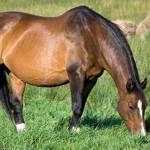Be Prepared Before Breeding a Mare

If you have even the slightest idea that you may want to breed your mare next spring, it’s never too early to think about the process of getting the mare into the best condition to achieve a successful conception, full-term pregnancy, and live birth of a healthy foal.
An important first step in breeding is deciding whether a particular mare is a suitable candidate for reproduction. Several things need to be considered in making this decision, as trying to get an unsuitable mare in foal can be expensive and frustrating.
One factor to consider is the mare’s general health. She should be in moderate body condition, not too fat but also not losing weight. She should be free of lameness, disease, and injuries or conditions like laminitis or arthritis that would make her uncomfortable with the additional body weight of pregnancy. Genetic testing can reveal whether the mare is a carrier of a heritable disease such as hyperkalemic periodic paralysis (HYPP) or polysaccharide storage myopathy (PSSM) that could be passed on to her foal.
If the mare has delivered one or more healthy foals in the past, she may be a better choice for breeding than a mare that has never produced a foal. First-time breeding of an older mare may take several attempts, and it is not unusual to go through an entire season without achieving a pregnancy. Even younger mares may not be good candidates if they have had a history of abortion, infection, dystocia (difficult birth), or twin conception.
Well before the time of breeding, a veterinarian should perform a reproductive soundness evaluation. This procedure will include a general physical examination as well as an assessment of the conformation of the area around the mare’s anus and vulva. The veterinarian will examine the reproductive tract by transrectal palpation or ultrasound to check for abnormalities of the ovaries, uterus, cervix, vagina, and bladder. Uterine swabs will be taken so cultures can be done to check for infection. A biopsy may be taken from the uterine endometrium to help determine whether the mare is able to become pregnant and carry a foal to term.
If an infection or other abnormal condition is found, the problem will need to be corrected before the mare is bred. This can take several weeks or months, so the owner should schedule the initial examination as early as possible in the breeding season. Even healthy mares may not conceive at the first breeding, and older mares or first-time prospective broodmares are even more likely to require several heat cycles before settling in foal. Beginning the process early in the season increases the likelihood of a successful breeding and pregnancy.
In the unfortunate event that a particular mare is shown not to be a good candidate for breeding, finding this out several months before the breeding season starts can give owners the time to choose a different mare before spring arrives.








